Passenger Rail: Rollin’ or Reelin’?📌
Vamobility: By All Means and Modalities. (Premise).
Tracking issues and incidents to either roll with or rail madly about…
CATCHER IN THE RIDE.
(1/11/25)—Old-line locomotives’ cowcatchers cleared stray livestock from their rails. Today’s trains instead plow live stupes off their tracks, car-catching them directly on the nose.
Most recently, a loopy motorist attempted to race around flashing crossing gates in North Miami Beach January 8, then inexplicably stopped on the tracks. Whereupon a high-speed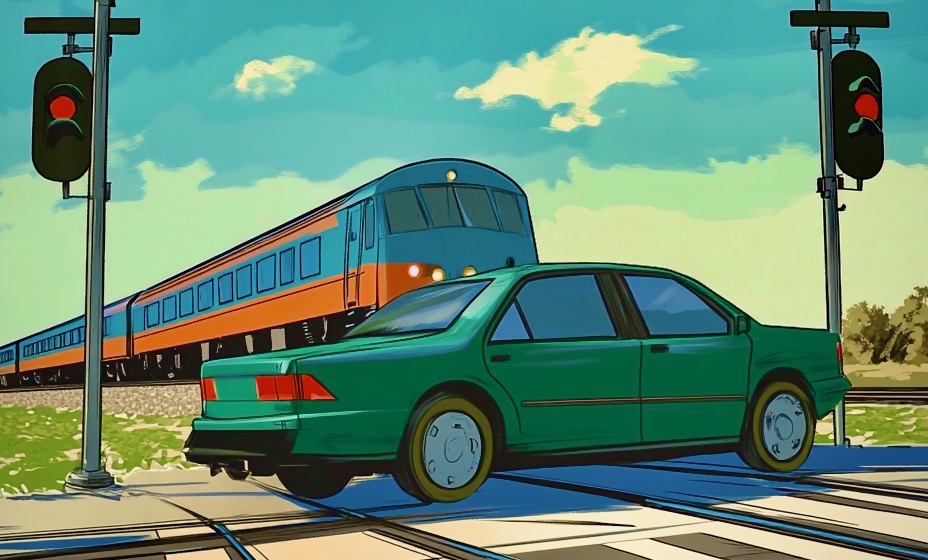 Brightline express caught the midsize car’s hindside, slamming it into the rail crossing’s light pole with an eruption of vehicle and train-snout debris. The lamebrain driver was hospitalized, no other major injuries reported.
Brightline express caught the midsize car’s hindside, slamming it into the rail crossing’s light pole with an eruption of vehicle and train-snout debris. The lamebrain driver was hospitalized, no other major injuries reported.
This, after a fire engine stalled on a Delray Beach rail crossing December 28, another Brightline train slicing it in two, injuring three firefighters and 12 passengers. Though not on emergency call, the rescue truck, having waited for a freight train to pass in the opposite direction, proceeded around a lowered crossing gate with red caution lights flashing, the Brightliner unable to stop in time.
What’s the Catch?
The common causeways here: Florida’s expanding rail service, rights of way and railroad crossings in stops like Melbourne, Rockledge and Micco. According to federal data, 370 people have been killed in Sunshine State train incidents since 2017, involving 13 different companies. Factors beyond crossing gate vs. vehicle skaters (i.e., barrier bypassers) include heedless pedestrian walkers or runners along railways or across them; drivers falling asleep at the wheel—even suicide by train, as in splaying across the rails.
More specifically, 34 people were killed between September ’23 and June ’24 along Brightline’s 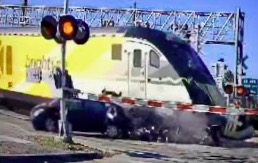 entire route, which currently extends from Orlando to Miami. Brightline, a sleek high-speed rail service in South Florida since 2018 ☟, was not found at fault in any of these incidents, by either the NTSB or Florida Department of Transportation.
entire route, which currently extends from Orlando to Miami. Brightline, a sleek high-speed rail service in South Florida since 2018 ☟, was not found at fault in any of these incidents, by either the NTSB or Florida Department of Transportation.
Be that as it may, remedial solutions have been highballing of late, not least wider (bi-lane) crossing gates, more fencing and barriers, amplified oncoming train horns/whistles, increased public awareness/ education. The FDOT has announced a $45m plan for just such an information program. While the USDOT has allotted $1.1bn for a Railroad Crossing Elimination Grant Program to include the study/improvement of grade crossing safety nationwide—particularly given the growth of high-speed trains.
Meantime, heads up: keep eyes and ears peeled on approach to railroad crossings, only entering one if you can drive/peddle/walk through without stopping, even in the event warning lights start flashing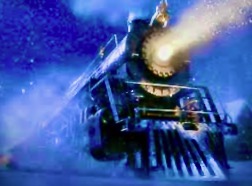 and gates are coming down. Because these trains can’t stop on a dime, on a dollar or doubloon for that matter. Should your vehicle actually stall on the tracks, best to bail out immediately, walking toward the oncoming train and away from the rails at a roughly 45-degree angle. This way, if said railiner collides with your ride, the wreckage will fly away in the same direction as the train itself.
and gates are coming down. Because these trains can’t stop on a dime, on a dollar or doubloon for that matter. Should your vehicle actually stall on the tracks, best to bail out immediately, walking toward the oncoming train and away from the rails at a roughly 45-degree angle. This way, if said railiner collides with your ride, the wreckage will fly away in the same direction as the train itself.
Otherwise, it could be a catch-as-catch-can crapshoot, and that’s looking on the bright side at best. (MTC…)![]()
THE FRENCH DISCONNECTION.
(7/29/24+)—Is this any way to ruin a railroad? On the very dawn of the Olympics’ opening day?
But borks happen, and in this case concerted incidents of sabotage shut down much of France’s high-speed rail network last Friday morning, disrupting passage of millions who were traveling to the Paris Olympic ceremonies and summer vacations throughout Europe. System recovery has since taken days.
The organized vandalization shut down virtually all but the Paris-to-Marseille southeast line (attack thwarted by maintenance crews) and throttled Eurostar cross-channel service. 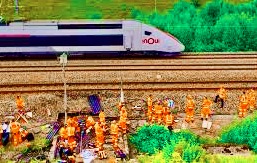 Saboteurs adroitly set fires, soldered open protective rail switch covers, and cut, burned cables in the rainy dark of night. Seems they intentionally keyed on switching stations—signaling system nerve centers proximate to where tracks forked in separate directions—rather than the rails or overhead electric wires.
Saboteurs adroitly set fires, soldered open protective rail switch covers, and cut, burned cables in the rainy dark of night. Seems they intentionally keyed on switching stations—signaling system nerve centers proximate to where tracks forked in separate directions—rather than the rails or overhead electric wires.
Orange-vested workers scrambled all weekend to repair the railway breaches. These cables keep traffic controllers/ supervisors abreast of precisely where 185-mph TGVs and other trains are located on the high-speed lines at any given moment—amounting to some 1,500 trains traveling 1,800+ miles every day.
Très Railroaded.
Nefarious, knowledgeable operation, all right: French security authorities currently pin it on culprits ranging from Russian goons to Iran terrorists to far-leftwing anarchist groups. Variously, Moscow happens to be angry over France’s sale of weaponry to Ukraine and flag-bearing Russian banishment from the Olympic Games. While Iran is vengeful over Gaza. As for French anarchists, they just seek to overthrow President Emmanuel Macron’s government no matter what or how.
To be sure, such railway sabotage has surfaced before: A similar electric cable box fire near Paris in January, 2023; an April, 2023 signal structure fire in southwestern France; the 2008 ‘Tarmac Nine’ caper—young thugs allegedly shorting out 25,000-volt power lines with 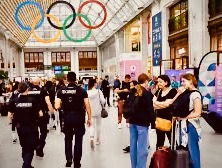 horseshoe-shaped iron bars. Alas, no suspected perps have ever been convicted on resulting charges of conspiracy and/or damage to French national interests.
horseshoe-shaped iron bars. Alas, no suspected perps have ever been convicted on resulting charges of conspiracy and/or damage to French national interests.
But hitting the 2024 Olympics on the biggest opening day in its history? Come on—what do these railbreaking bâtards want, a medal or something? If so, Vamigré says make it out of roadbed ballast, electrified, at that…Sacré Bleu! (MTC…)
AT WARPED SPEED.
(7/27/24)—They call it working the kinks out, if only the kinks would play along.
Kinks being the bends and buckling steel rails can succumb to when overexposed to direct, prolonged heat and sun, forcing trains to cut speed or downright stall in avoidance of dreaded derailments. And this summer has been cooking up plenty of both.
Amtrak, for one, has doubled its weather-caused delays over 2018, logging more since 2023 than at any time in the last 20 years—heavy rains adding to its trains’ slow-rolls and breakdowns, particularly along the US Northeast Corridor. Antiquated infrastructure meets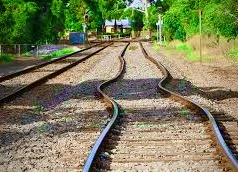 climate change: Heat domes, flash flooding, wind/lightening storms, tornados, hurricanes and raging wildfires wreak damage on railway lines from the mid-Atlantic to Mojave Desert, some rickety stretches dating back to the 1930s.
climate change: Heat domes, flash flooding, wind/lightening storms, tornados, hurricanes and raging wildfires wreak damage on railway lines from the mid-Atlantic to Mojave Desert, some rickety stretches dating back to the 1930s.
Kinks’ Latest Hits.
That aging infrastructure, power pantographs to ballasted roadbeds, is said to ‘sag and crumble’ in extreme (regional) heatwaves and heavy rains, increasingly causing blanket speed orders (80 mph max), if not outright train cancellations.
What to do? Systemwide upgrades require substantial investment, monies that Amtrak does not come across easily. First, the federally owned passenger-rail company does not own the vast majority of track upon which it travels (Northeast Corridor and certain Midwest lengths excepted). Instead it leases rights of way from existing freight lines that basically maintain running/rolling conditions to meet their schedules and needs—while controlling the issuance of those warped speed orders.
Furthermore, the federal funding needed to begin meeting the costs of such upgrades is continually under Congressional review. Big ways but little means: indeed, House Republicans  attempted to cut Amtrak’s overall budget by more than 60% last year, the bipartisan infrastructure law passed in 2021 notwithstanding. Otherwise there is the prospect of direct federal grants, wobbly as that may be. ☟
attempted to cut Amtrak’s overall budget by more than 60% last year, the bipartisan infrastructure law passed in 2021 notwithstanding. Otherwise there is the prospect of direct federal grants, wobbly as that may be. ☟
This, as Amtrak ridership has increased 18% over a strong ‘Covid revenge’ comeback year in 2023, and new rail lines are gathering steam—intercity to long-haul, from Florida to California, Brightline to Dreamstar. Passengers cite rising airfares, airport/ highway congestion, reliability and more casual comforts, so increasingly ride the rails.
Let’s just hope we can dodge the steely distortions when we do, and not rock ‘n’ roll into sun or rain kinks around the next wobbly bend. All ‘board! (MTC…)
CROSSING THE LINE.
(7/16/23)—The latest Amtrak grade crossing collision occurred Friday night (7/14) in Lakeland, Florida, when Train 92 plowed into a stuck tractor-trailer rig hauling seven motor vehicles.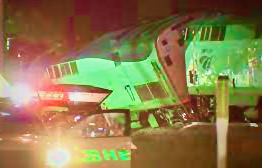
Amtrak reported that eight were injured, none fatally, aboard an express line train that was carrying 166 passengers and 10 crew from Miami to New York City. The locomotive derailed from the CSX-operated tracks upon contact, stopping some 200 yards beyond, leaking diesel fuel that “miraculously” never caught fire. No other cars jumped the rails; the truckers themselves had fled their cab just in time.
How/why the semi-truck was stalled at a crossing equipped with stopping gates and flashing lights—which apparently activated after the fact—was being investigated by local authorities, Amtrak officials and the NTSB. (MTC…) ![]()
WATER CRUNCH SANDWICH.
(6/29/23)—Amtrak’s crack Coastal Star Light collided with a water truck in Moorpark, California 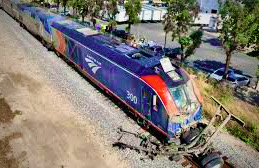 Wednesday, 15 passengers suffering relatively minor injuries, while the truck driver, who had barely bailed, was diagnosed with head trauma.
Wednesday, 15 passengers suffering relatively minor injuries, while the truck driver, who had barely bailed, was diagnosed with head trauma.
Train Number 14, bound from Los Angeles to Seattle with 198 passengers and 13 crew, struck the Ventura County irrigation vehicle at a farmland rail crossing 50 miles northwest of downtown L.A.. Three double-deck coaches of the seven car train derailed upon contact at 11:15 a.m., tilting sideways though remaining precariously upright. But yellow water truck debris was scattered about the crash site.
“We heard a big bang,” said one passenger, “then our car started teetering up and down, left and right—gasoline smell and dust flying everywhere.” It was unclear whether the water truck, headed for a nearby 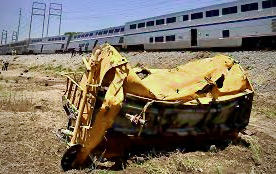 ranch, had actually stalled on the ungated rail crossing, yet there it was, fixing to get lunched, wrong place and time.
ranch, had actually stalled on the ungated rail crossing, yet there it was, fixing to get lunched, wrong place and time.
Detrained riders were gathered in Moorpark’s Senior Center for alternative routing, according to Amtrak officials. Crews worked through the night into Thursday to remove the engines/train cars and clear tracks.
Nevertheless the national rail network announced that no California coast lines would be running north of L.A. anytime today. (Having since resumed). (MTC…)
HANDMADE GREEK TRAGEDY.
(3/2/23)—In Greece’s worst railway accident, 57 perished, more than 70 were injured and 10 are reportedly still missing as a passenger train collided head-on with a freight train erringly routed onto the same track over some 11 miles back. Among the dead are eight rail workers, including the drivers manning each engine.
The fiery crash occurred just shy of midnight (2/26/23), derailed forward coaches accordioning down a right-of-way embankment in the Valley of Tempe outside Larissa City. The through train, bound for Thessaloniki from Athens, carried 350 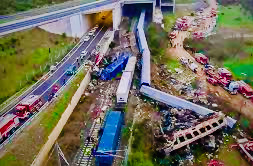 passengers—many in their 20s-30s, students returning from Orthodox Lent carnival celebrations. Survivors told of escaping the smoky, oven-hot coaches by breaking out of jammed, crumpled windows and doors
passengers—many in their 20s-30s, students returning from Orthodox Lent carnival celebrations. Survivors told of escaping the smoky, oven-hot coaches by breaking out of jammed, crumpled windows and doors
“A horrific rail accident without precedent in our country,” said Greek Prime Minister, Kyriakos Mitsotokis, who cited “tragic human error” as the explosive disaster’s cause. His Transport Minister accepted responsibility and resigned; a local stationmaster was charged with manslaughter by negligence, amid a rush of investigations.
But most critics further blamed “long-standing failures” to fix an outdated rail system nowhere near 21st Century ready. Here hand signals, passed along notes and phone calls chugged far behind technologically advanced operational systems elsewhere: evidently the ballasted residue of chronic governmental underinvestment and delays.
With rescue, salvage crews still clearing the deadly wreckage—heavy machinery lifting, moving large sections of buckled train cars—rail workers held a one-day strike railing against systemic neglect and disrespect, while protestors picketed Athens’ Hellenic Train headquarters. All were calling for justice and swift, thorough rail system reform.
Alas, given Greece’s long-haul economic woes, it looks like that express train may have already left the station. (MTC…)
ANOTHER CRASH COURSE OF FEDEXcargo?
(2/8/23)—We’d been tracking the latest Amtrak rail crossing fricassée when it turns out this crash was more a main course of FEDEXcargo.
For within days of the Austin, Texas airport ‘near miss’, wherein a landing Federal Express Corp. 767 cargo jet came a hundred or so feet of ass-ending a Southwest Airlines 737 taking off on the very same runway (although air traffic controller error), now comes a mishap like this:
Here, a FEDEX cargo rig is involved in another near miss—only this miss hit, taking the life of the truck driver, Patrick Metz, 34. Specifically, his tractor-trailer blew off a stop sign and lost a chicken 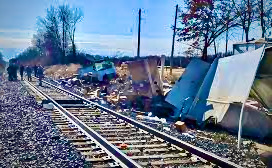 race with Amtrak Train No. 318 from Kansas City Tuesday morning, at a private grade crossing north of Pleasant Hill, Missouri. The tractor and cargo-loaded trailer were smashed to Large Box smithereens. No one onboard the ‘Lincoln Service/Missouri River Runner’ was injured, and 29 of its 35 passengers were charter bus bridged to the train’s St. Louis and Chicago destinations, while Train 318 was terminated onsite with significant windshield damage.
race with Amtrak Train No. 318 from Kansas City Tuesday morning, at a private grade crossing north of Pleasant Hill, Missouri. The tractor and cargo-loaded trailer were smashed to Large Box smithereens. No one onboard the ‘Lincoln Service/Missouri River Runner’ was injured, and 29 of its 35 passengers were charter bus bridged to the train’s St. Louis and Chicago destinations, while Train 318 was terminated onsite with significant windshield damage.
So apparently the fatal Missouri rail collision was a case of FEDEX driver negligence, if not utter recklessness—but who knows what sort of pressure he was under? Still, it does heighten the issue of private property crossing signage. This South Hereford Road crossing, at grade level, is privately held, thus the owner is not required by federal or state regulations to install any warning/control markings or devices. In this case, ownership only shelled out 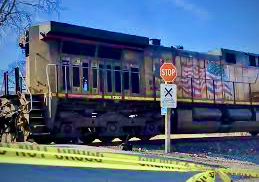 for standard red stop signs in both vehicle traffic directions.
for standard red stop signs in both vehicle traffic directions.
Missouri has some 3,500 of these ‘passive intersections’, and the NTSB, along with Amtrak and Operation Lifesaver, have been pushing for warning lights and bells at these mainly rural crossings since the 1990s. Indeed, just seven months earlier, another Amtrak train jumped the rails after colliding with a dump truck at a similar crossing outside Mendon, MO.
Vamigré is hoping such private property crossing upgrades and a thorough investigation of both FEDEXcargo-related incidents are signed, packaged and delivered at better than a snail’s pace—but we’ll be tracking sapid menus and movements until they do. (MTC…)
ALL ABOARD, RESTORED?
(12/2/22)—President Joe Biden has just signed into law a prohibition of the threatened nationwide railroad strike, set for December 9. Solidifying an earlier rail labor agreement, the directive increases railway workers’ pay 24%, but falls short on their unions’ paid sick-day demands. There likely will be more grumbling and haggling over the latter score (which ‘Amtrak Joe’ does anticipate). But for now, US freight lines, and more importantly Amtrak, will continue rolling along into the critical holiday season 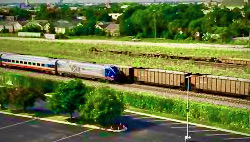 and beyond. (MTC…)
and beyond. (MTC…)
(11/29/22)—Striking a blow against an on-again freight rail/labor derailment that could cripple the US economy, Amtrak has just released its 2022 ridership numbers through September 30, albeit with a December 9 strike deadline date looming around the bend. Still, the nation’s passenger railway system appears to be on an increasingly positive track, posting an 89% (10m+) rider increase over 2021, to 22.9 million passengers—nearing 85% of pre-pandemic levels in the last six months of this budget year. Further, Amtrak projects reaching 90%+ of pre-COVID ridership by September 2023.
Paring the system’s adjusted operating loss by 18.2% over 2021 (to $888.4m), Amtrak claims it is “bucking the trend of continued lower ridership seen on most commuter railroads and public transit systems.” The rail network reports it has added 11 more routes (with state/federal partnership) and employed 3,700 new workers in 2022. Beyond that, it seeks to add some 39 corridor routes and 166 cities by 2035.
The Biden administration is fully onboard, asking Congress for $3bn in annual Amtrak budgeting for 2023, up from the current $2.33bn. But first must come legislative action on freight-rail conductor and line maintenance unions’ pay/paid sick days-or-strike demands—much less resolving freight railroads’ PSR worker efficiency issues—if that Amtrak train is to even leave the station. (MTC…) ☟
DUAL-TRACK DISHARMONY.
(9/15/22) Update—Amtrak’s fraught dependency on freight line tracks (as detailed below) is only ‘underscorched’ by its near derailment due a looming nationwide freight carrier labor strike, only settled for the moment via days-long negotiations and Biden administration jawboning.
The nation’s passenger rail system had warned of scrapping major runs coast to coast (intercity, 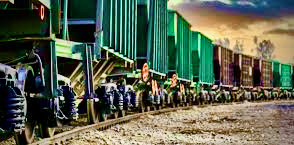 regional and long-distance) if its host freight lines such as Union Pacific, BNSF and CSX shut down their tracks and operations Friday, should a labor agreement with railroad workers union leaders not be reached. Least affected would have been Amtrak’s Northeast Corridor, trackage which the system itself controls.
regional and long-distance) if its host freight lines such as Union Pacific, BNSF and CSX shut down their tracks and operations Friday, should a labor agreement with railroad workers union leaders not be reached. Least affected would have been Amtrak’s Northeast Corridor, trackage which the system itself controls.
The first US rail strike in 30 years was averted late Thursday, however, with Amtrak abruptly cancelling any Friday service/route redballing. Still, the system’s latest threatened train de-action ever heightens long term concern over its rank, rent dependency on freight rail’s ballast and roadbeds.☟
(7/20/22)—Looks like Amtrak Joe’s express may be grinding to a whistle stop, if not derailing altogether—at least on a certain Gulf Coast line.
Packing bipartisan federal approval and some $66bn to further build out the national passenger rail service, the Biden administration has nevertheless hit something of a sidetrack in Bayou Country, Biloxi and beyond. This particular leg of Amtrak’s expansion is designed to restore passenger service between New Orleans and Mobile, Alabama swamped by rail infrastructure flooding during Hurricane Katrina 17 years ago. It is one of 39 new routes as part of Amtrak’s goal of reaching significantly more 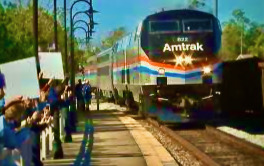 cities and towns. But rail heading off plans for the 140-mile re-opening is a ‘hotbox’ of Gulf of Mexico port interests.
cities and towns. But rail heading off plans for the 140-mile re-opening is a ‘hotbox’ of Gulf of Mexico port interests.
Tug of Rails.
Now where do they get off? Firstly, consider the mandate: When Congress created Amtrak in 1970, it stipulated that private railroad companies—which it essentially bailed out of money-losing intercity passenger services—would provide Amtrak trains rental access ($135m paid in fiscal 2021) to their freight line tracks, and ‘preference’ over other rail traffic.
So it comes down to a matter of who ultimately controls those tracks, freight or passenger rail—an ongoing territorial trainwreck from the get-go. Amtrak complains about schedule slow-ups and shoddy roadbed/signal/safety maintenance, claiming for example that long, heavy hauling freight trains caused nearly 900k minutes of passenger delays in 2021 alone. Amtrak administrators (a $six-figured lot: draw/retention bonus pay inversely related to performance) maintain the Gulf Coast leg is a necessary single track, “lightly used mainline” prime for renewed (and essential) passenger service.
Freight railroad owners counter that tenant Amtrak oversteps its authority, ever pressuring them to share their tracks with added passenger train capacity. In this case, CSX says it runs 8-10 freight runs on this Gulf Coast stretch, along with other local trains and mechanical equipment, at a busy time of widespread supply chain demands and disruptions. Moreover, the freight line owner accuses Amtrak planners of seeking to increase passenger train frequency (above pre-Katrina levels) during peak hours, and disputes ‘low-balling’ Federal Railroad Administration (FRA) estimates of restoration capital investment to the tune of $300m. So they say no way to this added two-way without more study.
The Gulf Between…
No harmony there, alright: six years of Gulf Coast talks have been a chugging nowhere. A Southern Rail Commission of state appointees from Louisiana, Mississippi and Alabama has been pushing to bring the New Orleans-Mobile train back for well over a decade, even helping land a $66m allocation for needed 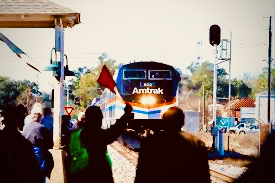 rail improvements. Meanwhile the Ports of Mobile, city of Mobile and Alabama all seek to derail Amtrak’s move, arguing that it would adversely impact the transport of 58m tons of crucial cargo per year.
rail improvements. Meanwhile the Ports of Mobile, city of Mobile and Alabama all seek to derail Amtrak’s move, arguing that it would adversely impact the transport of 58m tons of crucial cargo per year.
Thus this trial by test case: the Surface Transportation Board, an independent federal agency, will mediate Gold Coast service restoration—evaluating whether it would “impair unreasonably freight transportation.” The STB’s owner vs. tenant power determination may also semaphore prospects for service expansion throughout Amtrak’s system nationwide. But either way, ‘service delayed is service denied’, states the FRA, in a time of climate change, soaring gasoline ppgs and increasing rail ridership as a means of ‘personal mobility equity and economic vitality’.
Vamigré will surely track and high-ball these proceedings, eager to see who ends up taking whom or what for a ride…as in who will ultimately rule the rails. (MTC…)
TIPPING THE RAILS.
(6/29/22)—Going the slower, more casual and grounded route, really seeing rather than overflying the world sounds dreamy yet becomes a bit more problematic, given the derailing immediacy of Britain’s nationwide rail strike. But even that crippling work stoppage gets sidetracked by news of a massive 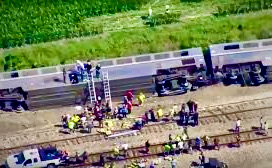 Amtrak train wreck outside Mendon, Missouri on June 27. The system’s fabled Southwest Chief bound for Chicago from Los Angeles comfortably at 87 m.p.h. collided with a dump truck at a rural crossing—killing four passengers plus the truck driver, injuring over 50. Update: The dump truck has since been cited as the accident’s ‘official’ culprit.
Amtrak train wreck outside Mendon, Missouri on June 27. The system’s fabled Southwest Chief bound for Chicago from Los Angeles comfortably at 87 m.p.h. collided with a dump truck at a rural crossing—killing four passengers plus the truck driver, injuring over 50. Update: The dump truck has since been cited as the accident’s ‘official’ culprit.
Two locomotives and eight coupled double-deck rail cars overturned, some 243 trapped passengers and crew of twelve climbing, crawling out broken windows and doors into remote farmland. Issue number one here is that the crossing was uncontrolled, having no flashing signals, mechanized gates nor warning lights along such a mainline long-haul freight and Amtrak stretch of roadbed. There is at least one crossing per mile or so of railroad track nationwide, about 130k of these ‘passive’ crossings in the country’s rail network that could pose such hazards.
The Mendon accident occurred a day after another Amtrack train hit a vehicle in Northern California, killing three, and still another collided with a passenger vehicle near Birmingham, Alabama, killing its driver. The NTSB has arrived in Mendon to investigate that crash, while the Department of Transportation says it will also examine the broader issues of Amtrak/crossing safety, particularly the costs of fully installing adequate crossing control throughout the US rail system. No stoppin’ ’em, so look both ways…all aboard? (MTC…)
TRAINING YET ANOTHER GUN.
Independence, MO: 1/16/22—Once again, an Amtrak train becomes a shooting gallery on rails, this time outside Lee’s Summit, Missouri in the virtual dead of night. A passenger identified as Richie T. Aaron Jr., 30, was apparently shot while Train 313, bound for Kansas City from St. Louis, idled by the Lee’s Summit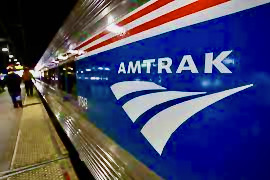 station at approximately 9:00 p.m. The suspected gunman was said to have fled the coach, and is still at large at the moment.
station at approximately 9:00 p.m. The suspected gunman was said to have fled the coach, and is still at large at the moment.
None of the other 80+ passengers or crew sustained injuries, and confused fellow riders in the sparsely occupied car told Independence authorities they had heard the shot but didn’t initially realize the victim had been hit. Still, the further ‘derailing’ nut of this fatal incident is not what these witnesses recounted, but where.
Because rather than calling for emergency assistance in Lee’s Summit, the Amtrak crew inexplicably left the station—despite passengers’ calls to hold the train for an ambulance—Train 313 chugging north toward the next stop with a dying man onboard. Some 35 long minutes later, Independence police said life-saving paramedic efforts could not revive Aaron, who expired in his seat.
As fellow passenger Chris Shaw put it, “If you’re on a train or a plane…and you hear gunshots, you…(stop the train and) call the police. You don’t wait 40 minutes…the guy dead, laying in his seat…there should have been an ambulance at Lee’s Summit…”
Amtrak’s official response thus far: “(We are) supporting local (Lee’s Summit) authorities who are 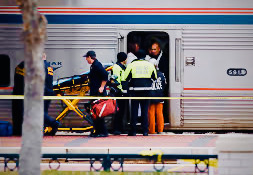 investigating a tragic incident…involving two passengers on train 313. One of the passengers is a fatality, while the other left the scene…There were no injuries to the other 81 passengers and the Amtrak crew, and they all were provided alternate transportation to their final destination. Amtrak takes its responsibility for safe travel seriously…”
investigating a tragic incident…involving two passengers on train 313. One of the passengers is a fatality, while the other left the scene…There were no injuries to the other 81 passengers and the Amtrak crew, and they all were provided alternate transportation to their final destination. Amtrak takes its responsibility for safe travel seriously…”
Seriously? We’ll say how the nation’s railway system rolls with this latest onboard violence as the Lee’s Summit baggage is more fully unpacked. So looks like it’s showtime in the Show Me State. (MTC…)
FUNDING AND INSIDE ‘TRAK.
(1/3/22)—Steadfast ‘Amtrakies’ can finally tap brakes on their fiscal railing, as the nation’s passenger-rail 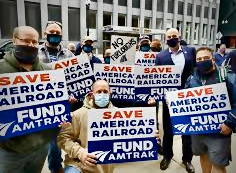
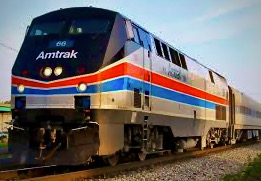 service gains a fresh head of steam into the new year—at the bottom line and top of its train chain.
service gains a fresh head of steam into the new year—at the bottom line and top of its train chain.
In an ‘Amtrak Joe’ Biden era effort to cannonball ahead, instead or routinely cannibalizing the system, Congress has approved $22bn in direct funding, with access to $44bn more in government and private sector loans. It is the largest portmanteau of federal largess in Amtrak’s 50-year history—for a rail system only coming even close to a break-even point once, in 2019.
The long-sought infusion will be geared toward shoring up and vastly growing passenger rail service 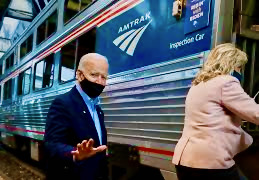 throughout the US, with particular focus on the busy Northeast Corridor. But increasing ridership in currently inconvenienced regions is top line as well—primarily via expanded routes and scheduling frequency—all the while maintaining the long-distance runs prized by powerful legislators.
throughout the US, with particular focus on the busy Northeast Corridor. But increasing ridership in currently inconvenienced regions is top line as well—primarily via expanded routes and scheduling frequency—all the while maintaining the long-distance runs prized by powerful legislators.
This considerable rail portion of Congress’s infrastructure bill will reportedly go to capital improvements: repairing/ replacing tracks, roadbeds, and building/rebuilding railway stations. Moreover, Amtrak will upgrade its rolling stock with a $3.4bn order of 73 new trains from Siemens Mobility, Inc..
Streamliner Steve?
Unlike with Amtrak’s past top execs (largely aviation industry-oriented), the hand on its re-stoked throttle now belongs to Stephen Gardner, the line’s fifth CEO since 2016. By contrast Gardner, 45, apparently has iron horses in his blood, coming up through the system’s ranks, beginning as an unpaid 18-year-old Amtrak intern. This new honcho has consistently been an advocate for and architect of expanded rail service between cities coast to coast.
All along he has built his rail career on adding Amtrak revenue and championing new trains and tracks; at the same time sustaining the federal government’s $2bn annual operating support, particularly so when 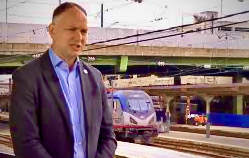 certain other lawmakers persist in seeking to turn the rail agency into a legislative third rail.
certain other lawmakers persist in seeking to turn the rail agency into a legislative third rail.
Gardner briskly proclaimed that, “For many decades Amtrak was defined by surviving against the odds—hanging on and employing duct tape, baling wire, whatever to keep this place together…(now) we finally have the resources…we’re not going to miss this moment.”
So alllll aboard, right? Vamigré will see if this dedicated new engineer can get and keep Amtrak on smoother, straighter track at long last. For that’s just how we roll. (MTC…)
FOUND PACKING…AND LACKING.
Tucson: 10/4/21—Amtrak’s north country Montana woes☟ran quickly southward Monday morning when the National Railway’s Sunset Limited streamliner became a dramatic shootout scene at a downtown Tucson, Arizona train station.
No mere Wild West, OK Corral theatrics there, however, as a federal drug enforcement agent was killed, two more were injured, along with a Tucson police officer in a near half-hour siege.
Amtrak Train 2, bound from LA to New Orleans carrying 137 passengers and a crew of 11, pulled into Tucson at 7:40 AM (Pacific time) for a scheduled 30-minute stopover. Regional DEA joint task force agents promptly boarded a rearward double-decker car to conduct to a routine sweep for such contraband as illegal guns, money and/or drugs—a search said to be SOP ‘at all transit hubs’. Accounts later revealed the DEA agents were acting upon a tip from Amtrak: that two suspects may be carrying drugs onboard.
While questioning one of the riders in question, agents spotted suspicious bags near him in the upper level of the coach, directing him to deboard as they inspected the pair’s luggage on the station platform. Once a significant stash of marijuana was sniffed out by a K-O dog, agents followed the suspect back aboard the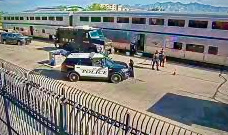 coach to detain him, whereupon his partner opened fire on the DEA men. After exchanging rounds with the officers, some 20 shots in about 1½ minutes, that second suspect fled downstairs.
coach to detain him, whereupon his partner opened fire on the DEA men. After exchanging rounds with the officers, some 20 shots in about 1½ minutes, that second suspect fled downstairs.
Another armed security officer was soon seen on video entering the train with a leashed K-9 dog through an adjacent car, and more shots were fired inside the coach. That same officer was then shown fleeing the train with his dog—that shadowy second suspect emerging in the car’s doorway to shoot at the policeman as he retreated behind a station structure, barricading along with other armed officers who were drawing a bead on the rail cars. Meanwhile a Tucson SWAT team motored up onto the boarding platform, running toward the coach with assault rifles in hand, terrorized passengers helplessly hunkered down and witnessing it all through train windows.
Within nearly 20 minutes, authorities were gaining control of the scene, one of the suspects leaving the train with his hands up in surrender, surrounded by officers; the gunman, who had since locked himself in a lower level bathroom, was found dead—apparently shot by arriving back-up officers.
Dopin’ to New Orleans.
So other Sunset Limited passengers eventually detrained without further incident—told to flee from the train ‘in the opposite direction’ or escorted off by officers to a bloody clot of flashing emergency vehicle 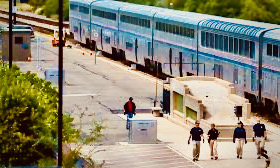 lights and a tangle of yellow caution tape. Some waited hours to board a rerouting of ‘bridge’ busses, others told of being stranded even longer, what with Train 2 being waylaid as a crime scene, and FBI agents joining the investigation.
lights and a tangle of yellow caution tape. Some waited hours to board a rerouting of ‘bridge’ busses, others told of being stranded even longer, what with Train 2 being waylaid as a crime scene, and FBI agents joining the investigation.
Now if such DEA-style sweeps are in fact standard operating procedure at ‘all transit hubs’, how were these miscreants able to board that premier Amtrak train with loaded firearms and scads of weed in the first place? And where are the TSA-style security checkpoints to detect such weaponry and potential rail rage? Why was even basic wanding found so wanting?
As in why should National Railway System passengers be any less safe than airline passengers, train/bus stations any less secure than airports—that is, if these surface modes are marketing themselves as desirable alternatives to overcrowded skies?
Because given terrifying Amtrak scenarios like the Tucson shootout, there is nothing OK about that. Still, it’ll take more than mere railing to get this ‘Ambre’ back on trak. (MTC…)
☟RIGHTING THE JOPLIN JUMP.
9/26/21—Remote, relatively flat land, gradually curving stretch of track, bright sunny afternoon: Hardly the scenario for a railway catastrophe.
Yet that is what went down outside Joplin, Montana at about 4 pm (Mountain Time) last Saturday, when a westbound Empire Builder streamliner jumped the tracks, killing three passengers (possibly ejected), injuring scores more. 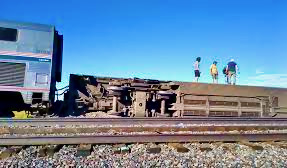 Amtrak train number 7/27, headed from Chicago to Portland/Seattle carried 141 riders and a crew of 16—cruising along near the Sweet Grass Hill country of ‘Big Empty’ Montana, some 30 miles south of the Canadian border.
Amtrak train number 7/27, headed from Chicago to Portland/Seattle carried 141 riders and a crew of 16—cruising along near the Sweet Grass Hill country of ‘Big Empty’ Montana, some 30 miles south of the Canadian border.
Suddenly the twin-engine, ten-car train “experienced extreme turbulence,” according to once evacuee–namely 10-15 seconds of rocking, noise and smoke before grinding to a stop. Within minutes, it became clear that eight of the cars had left the rails–jumbling, snaking across two roadbeds. At least three had fully tipped over on their sides.
Passengers staggered off the double-decker coaches, milling about the crash site in the middle of nowhere, luggage and other personals strewn around them. Those more severely injured were rushed to hospitals in Shelby and Havre; others were transported to nearby hotels and shelters as locals provided food and comforts.
Cause and Defects.
With cranes and bulldozers cautiously righting and clearing the accident site, the National Transportation Safety Board has dispatched a 14-member ‘Go Team’ to investigate the cause or causes of the crash—the 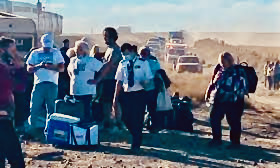 first major Amtrak mishap since a fatal December 18, 2017 derailment of an inaugural Cascades train outside Tacoma, Washington.
first major Amtrak mishap since a fatal December 18, 2017 derailment of an inaugural Cascades train outside Tacoma, Washington.
Rail industry observers speculate that either train track or equipment are suspect, since human error has been “virtually eliminated” through Amtrak’s systemwide Positive Train Control. So they say—moreover Burlington Northern Santa Fe Railway (BNSF), owner/operator of this (mainly freight) route, claims these particular tracks were inspected just “days before.”
Nevertheless, questions remain about rail, switch and roadbed maintenance. Why, for instance, did the engines 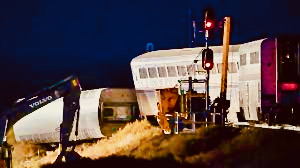 and first two cars remain upright, the derailment apparently not beginning until car #3? Why did coaches #5-7 tip over completely, with the rear cars jumbled but still upright? But if the tracks aren’t at fault, details must emerge as to signaling, operating speed (76-8 mph) and rolling stock maintenance (hot boxes). Could upcountry cross winds or even sabotage have been a contributing element, or will this be the usual nebulous ‘combination of factors’ determination? In any case, the NTSB once again foresees a months-long investigation here, given the potential complexity of this accident, much less pressures from those financially involved.
and first two cars remain upright, the derailment apparently not beginning until car #3? Why did coaches #5-7 tip over completely, with the rear cars jumbled but still upright? But if the tracks aren’t at fault, details must emerge as to signaling, operating speed (76-8 mph) and rolling stock maintenance (hot boxes). Could upcountry cross winds or even sabotage have been a contributing element, or will this be the usual nebulous ‘combination of factors’ determination? In any case, the NTSB once again foresees a months-long investigation here, given the potential complexity of this accident, much less pressures from those financially involved.
Same old, same old—except:
- Amtrak service between Minneapolis and Seattle is now indefinitely suspended, likely necessitating the brand rebuilding of the Mighty Empire Builder’s “…exciting adventure through majestic wilderness, following in the footsteps of early pioneers.” Especially since the EB run was only recently reinstated.
- Because a traveling public is already wary of boarding longer-haul US National Railway trains.
- While the anti-Amtrak chorus in Congress is salivating at the prospect of more red meat for their system bashing and budget slashing agenda.
Accordingly, Amtrak officials and other investigating parties (incl. Federal Railroad Administration experts) are well advised not to waltz around this ‘Joplin jump’ tragedy for so bloody long—Amtrak Joe’s patronage or no. (MTC…)
IS AMTRAK GETTING SCAMTRACKED?
Say It Ain’t So, Joe…
![]() Update: 9/6/2021—Instead, say trains are a go, ‘Amtrak Joe’. From the start, President Biden’s administration has pledged to “spark the second great railroad revolution.” Newbie Department of Transportation Secretary, Peter Buttigieg has stated that “…passenger rail is a vital component to America’s transportation network. I believe that the department should promote, help to develop, and fund passenger rail…to bring America’s railroads into the 21st century.” And Amtrak officials couldn’t climb aboard more eagerly for the ride.
Update: 9/6/2021—Instead, say trains are a go, ‘Amtrak Joe’. From the start, President Biden’s administration has pledged to “spark the second great railroad revolution.” Newbie Department of Transportation Secretary, Peter Buttigieg has stated that “…passenger rail is a vital component to America’s transportation network. I believe that the department should promote, help to develop, and fund passenger rail…to bring America’s railroads into the 21st century.” And Amtrak officials couldn’t climb aboard more eagerly for the ride.
Currently, the rail agency seeks to tap into the Biden Administration’s new infrastructure proposal to the tune of some $25b for expanding its network by adding 30 routes, and improving service along 20 more, between now and 2035, potentially increasing overall ridership from 34m to over 52m.
In the meantime the nation’s passenger rail system continues to chug and slug along under the weight of an 80% ridership, 50% revenue drop amid these pandemic times. For despite receiving $1b in the 2020 COVID aid 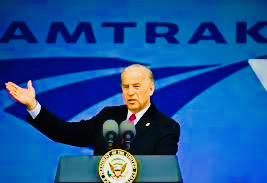 stimulus package, Amtrak struggles through employee issues, rolling stock failures, crumbling infrastructure and route-shrinking controversies, with Congressional resistance to further system bailouts.
stimulus package, Amtrak struggles through employee issues, rolling stock failures, crumbling infrastructure and route-shrinking controversies, with Congressional resistance to further system bailouts.
Nevertheless, growing segments of the US population are driving less, finding the vast distances between important places and services, from social lifelines to medical treatment, increasingly problematic, if not life threatening. Beyond leisure travel concerns, many small and/or rural towns across the country are in an existential battle, often for lack of reliable public transportation—not least throughout the Great Plains states and ‘Big Empty’ of Wyoming and Montana.
So this latest promise of an adequately funded and revitalized nationwide rail system is surely on time and target about now after years of deliberate neglect. To be sure, New York City’s remodeled Moynihan Train Hall and next-gen Acela service on the lengthened North East Corridor are fine starting points, potentially leading to longer-haul route extensions between Mobile and New Orleans; Chicago and St. Louis. Current Amtrak CEO Bill Flynn and President Stephen Gardner are also expressing interest in partnering with Colorado’s Front Range Passenger Rail Commission to provide and operate passenger rail service along the Pueblo to Cheyenne corridor, possibly with DIA and Boulder spurs, beginning on existing freight rail lines.
Indeed, Amtrak’s long-range nationwide expansion plan foresees new routes in/between populous, densely clustered areas lacking alternatives to air travel on trips of under 500 miles—at an overall implemental cost of $25b—with the projection of firmer system profitability down the line.
But more immediately, fiscal support for route stability; train to track/roadbed upgrades; safer signaling to accelerate smoother top speeds—as well as major station improvements and further development of high-speed projects—are all long overdue. Hence on the Congressional docket is reauthorization for the recurring surface transportation bill. Of particular concern to Amtrak officials is modifying Section 209 of the 2008 Passenger Rail Investment and Improvement Act, which can currently allow a single state to derail its tie of funding for an expansion effort of over 750 miles in length crossing multiple states.
Such a revision is particularly material, given certain pockets of insular resistance to using local funds to lay rail for Amtrak ‘land cruisers catering to wealthy retirees.’ Add to that the perpetual wrangling over track/right-of-way priority with rail/roadbed-owning freight rail companies, not to mention the countervailing pressure of maydaying air carriers.
So Vamigré will be keenly ‘trainspotting’ to ensure that Biden administration efforts to end all the Amtrak slamming and scamming don’t run off the rails along the way. Because we’re all aboard for re-engineering the sputtering agency into our hometown to high-speed Vamtrak of choice. (MTC…)
Update: October 21, 2020—Amtrak’s current CEO (since April anyway), William J. Flynn has just testified before the Senate Committee on Commerce, Science and Transportation that the nation’s railway system may have to cut 2,400 more jobs and significantly delay critical capital projects if it does not receive $28b in emergency funding by December.
According to Flynn, the beleaguered rail agency has suffered a 97% ridership drop, with a 53% revenue decline in this COVIDian year. Amtrak has already furloughed some 2,000 employees and is hitting the brakes on major infrastructure improvements, particularly in its busy Northeast Corridor—all ostensibly to “stave off bankruptcy.”
His emergency appeal would be part of a total $4.9b Amtrak budget request, layered upon a continuing resolution Congress passed in September to keep the trains running until December 11. By comparison, passenger airlines are asking for $25b in payroll relief, airports for an additional $10b in assistance.
But Senate lawmakers left and right in turn criticized the CEO du jour for his draconian cost-cutting policies, particularly his slashing of their pet, long-distance routes (in some cases daily frequency) serving over 220 communities—mainly rural, in the south, west and mountain regions. Rail industry analysts point out that these often essential train routes have actually been performing better through this pandemic year: traffic off 62%, whereas shorter, urban service has lost over 80% of its 2019 passenger volume.
For his part, Flynn assured committee members, if not fervid rail advocates, that these route cuts are temporary, contingent upon evolving coronavirus constraints, and would be reassessed in February 2021. That is if he is still at Amtrak’s throttle by then. (MTC…)
Update: November, 2020—Amtrak’s current CEO (since last April anyway), William J. Flynn has just testified before the Senate Committee on Commerce, Science and Transportation that the nation’s railway system may have to cut 2,400 more jobs and significantly delay critical capital projects if it does not receive $2.8b in emergency funding by December.
According to Flynn, the beleaguered agency has suffered a 97% ridership drop, with a 53% revenue decline in this COVIDian year. Currently operating at 20% of capacity, the system has been taking coronavirus safety measures, adhering to railcar cleaning/disinfecting standards every bit as stringent as those of the major airlines. Still, Amtrak has already furloughed some 2,000 employees and is hitting the brakes on major infrastructure improvements, particularly in its busy Northeast Corridor—all ostensibly to “stave off bankruptcy.”
His emergency appeal would be part of a total $4.9b Amtrak budget request, layered upon a continuing resolution Congress passed in September to keep the trains running until December 11. By comparison, passenger airlines are asking for $25b in payroll relief, airports for an additional $10b in assistance.
But Senate lawmakers left and right in turn criticized the CEO du jour for his draconian cost-cutting policies, particularly his slashing of their pet long-distance routes (in some cases daily frequency) serving over 220 communities—mainly rural, in the south, west and mountain regions. Rail industry analysts point out that these often essential train routes have actually been performing better through this pandemic year: traffic off 62%, whereas shorter, urban service has lost over 80% of its 2019 passenger volume.
For his part, Flynn assured committee members, if not fervid rail advocates, that these route cuts are temporary, contingent upon evolving coronavirus constraints, and would be reassessed in February 2021. That of course is if he is still at Amtrak’s throttle by then. (MTC…)
![]() Bulletin: As of March 10, Amtrak’s NY-DC Acela service will be Corona cancelled until May…as the national rail line cuts change fees, increases deep fleet cleaning and disinfection regimens…
Bulletin: As of March 10, Amtrak’s NY-DC Acela service will be Corona cancelled until May…as the national rail line cuts change fees, increases deep fleet cleaning and disinfection regimens…
Is Amtrak getting railroaded again—but good? Its trains may still be leaving the stations, but some killjoy riders may not be onboard for much longer. 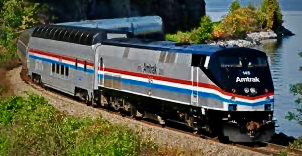
That is, if current Amtrak management has everything to say about it.
For in true Trump administration fashion, the president has made a reactionary, baldly counteractive appointment to head the nation’s passenger railway system. As with a coal executive to the EPA, Scalia Jr. with Labor, a charter school privatizer to the Education Department—a former airline chief was tabbed early on for the role of Amtrak CEO.
![]() Classic fox in the henhouse: Long Delta Airlines honcho Richard Anderson brought his flighty/hardball tactics and baggage to Amtrak in July 2017. The rail network’s board ostensibly charged him with stabilizing finances and improving operating reliability. It remains to be seen whether Anderson’s unpaid reign, which will end on April 15, might be somewhat counterbalanced by his replacement. William J. Flynn, chairman of Atlas Air Worldwide Holdings, looks to bring his long family railroad sentiments and ties to his new $474,000/yr CEO role—Amtrak’s rolling honcho turnover yet again (stay tuned).
Classic fox in the henhouse: Long Delta Airlines honcho Richard Anderson brought his flighty/hardball tactics and baggage to Amtrak in July 2017. The rail network’s board ostensibly charged him with stabilizing finances and improving operating reliability. It remains to be seen whether Anderson’s unpaid reign, which will end on April 15, might be somewhat counterbalanced by his replacement. William J. Flynn, chairman of Atlas Air Worldwide Holdings, looks to bring his long family railroad sentiments and ties to his new $474,000/yr CEO role—Amtrak’s rolling honcho turnover yet again (stay tuned).
No denying these issues have plagued Amtrak since it was bull rushed to assume control over U.S. passenger rail business some 48 years ago—oddly incorporated as a private corporation yet federal government owned.
Why? Because Congress had let the nation’s railroads abandon a money-draining passenger  service obligation long coupled with profitable freight carrying capacities. Back then the rail industry insisted that their passenger businesses were under siege from interstate highway/cheap gas alternatives to consumer travel. Not to mention faster, high-flying commercial airlines on the come like…Delta.
service obligation long coupled with profitable freight carrying capacities. Back then the rail industry insisted that their passenger businesses were under siege from interstate highway/cheap gas alternatives to consumer travel. Not to mention faster, high-flying commercial airlines on the come like…Delta.
Strength In Numbers?
From the outset, Anderson (who’s working without pay) assessed that Amtrak’s woes were a ‘math problem’, that he could boost revenue and ridership while slashing annual operating losses of over $170m to nil by 2021.
Now to his credit, this tight-fisted, bottom line CEO has since pushed for anti-crash positive train control (PTC) throughout the nation’s rail system; no-fault (i.e., whistleblower) protected reporting and ending punitive safety rules to encourage frank disclosure of problems and/or potential dangers.
Anderson has also backed modernizing changes in the Federal Railroad Administration’s ban on train cab cellphones, tablets and other screens (so-deemed ‘dangerous distractions’)—as he had with Delta—even doubling down in the wake of Washington State’s fatal overpass derailment.
Anderson has also been squeezing vendors and commercial partners, getting states and commuter-rail entities to shoulder more service costs. Moreover, they have axed hundreds 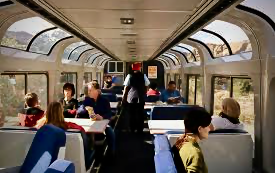 of management and consulting jobs via buyouts. This, while lauding his management team for increasing ridership revenue by cutting by cutting discounts and free passes, revamping marketing via search-effective advertising—to the tune of 900,000 more riders in 2019, 32.6 million more trips.
of management and consulting jobs via buyouts. This, while lauding his management team for increasing ridership revenue by cutting by cutting discounts and free passes, revamping marketing via search-effective advertising—to the tune of 900,000 more riders in 2019, 32.6 million more trips.
Decommission Accomplished?
At the same time, the CEO has tasked Amtrak with shuttering call centers, cutting many phone/fax lines, scrapping wireless/Wi-Fi advancement, as well as seatback TV screen installations. Even trimming the Amtrak police force, despite Congressional pushback.
Anderson terms it streamlining the company. His mission? “To provide efficient intercity passenger rail mobility consisting of high-quality service that is trip-time competitive with other intercity travel options.”
The key word here is intercity, particularly in reference to Amtrak’s populous Northeast 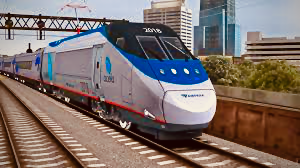 Corridor. Crowned by the Acela Express train, the service between Washington D.C. and Boston has been increasingly profitable, earning over $500m (adjusted) in 2018 alone.
Corridor. Crowned by the Acela Express train, the service between Washington D.C. and Boston has been increasingly profitable, earning over $500m (adjusted) in 2018 alone.
So clearly it is here and on other interurban routes where Anderson’s regime aims to ‘lay its rails’ moving forward. And that happens to be precisely where Amtrak’s routes and fortunes diverge.
The Incredible Shrinking System.
“It’s supposed to be a national network…to run across the country…funded by the government,” says a Transportation Communication’s Union official. “It’s none of the things these guys are (now) trying to do. (Anderson’s) trying to run it like an airline.”
The nonprofit Rail Passengers Association agrees, stating that Anderson’s crew is highballing efforts to spur ridership and profits on regional intercity service at the expense 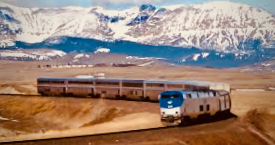 of venerable long-haul national routes—from the enduring Lake Shore Limited to the Empire Builder and California Zephyr.
of venerable long-haul national routes—from the enduring Lake Shore Limited to the Empire Builder and California Zephyr.
Team Anderson points out that Amtrak’s 15 long-distance trains lost nearly $550m in 2018, with beginning-to-end ridership low, if not running out of steam. Huffing that “We’re not here to run museum,” staffers further proclaim that “we’re here…to move people.”
Derailment By Design?
But critics counter that the Anderson plans amount to the diminishing of U.S. mobility. Their fear is this new ‘corridor’ approach goes beyond chronic Amtrak neglect and underfunding to slow death by systemic strangulation. So say former Amtrak executives such as the late, long-time CEO, Joseph Boardman, and numerous members of Congress.
Indeed, there does appear to be a movement afoot against rail mobility. Right-wing hacks roll out ballast loads of numbers to naysay U.S. passenger rail transportation from its very 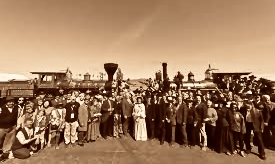 inception and Promontory Point.
inception and Promontory Point.
These think-tanked ideologues are motorbus hucksters from way back, asphalt and rubber sniffers who have been sucking up too many diesel fumes for far too long. Yet they wouldn’t be caught dead on some intercity motor coach to save their very political lives.
Such bus tools who bleed motor oil have been rewriting and derailing rail history since well before the Pacific Railroad Act in 1862. For one thing: motor coach hacks and flacks continue to deny the infamous offensive by GM, Firestone Tire and Big Oil to smoke the nation’s surface streetcar industry throughout the 1930s-40s.
These rail critics-for-hire have since called passenger service in the U.S. irrelevant, cynically detailing the demise of long-haul overnight trains in the 1950s and 60s—Talgo and ultralight Aerotrain advances notwithstanding. This ‘bustapo’ now consorts to drive the last spike in Amtrak’s national network, via context-free, mind-numbing numbers and sterile stat tables or spreadsheets—sniping at today’s hybrid rail progress like they potshot trains and trolleys earlier on.
The VamoScrooges’ verdict: Railroad trains can do no right; megabuses are just the ticket for today’s intercity blues—as they beat the oil drum for flag-waving fun and profit—with a high-handed governor now commanding the Amtrak throttle.
Negative Train Control.
Meanwhile, Team Anderson’s plans and schemes gather steam in the CEO’s quest to pare down the national network, beginning with its venerated long-distance routes. Citing figures that reveal comparatively low through ridership on runs of over 750 miles, Amtrak management now foresees major systemwide restructuring.
Essentially, Anderson seeks to slice and dice long-haul service, likes of the Sunset Limited and Southwest (Super) Chief. In its place, his ‘scAmtrak’ vision is a farrago of intercity corridors—sections apparently patched together by, what else? Short-haul air carriers and/or some sort of ‘bus bridges’: all aboard on that? Sounds more like ‘half-Trak hopscotch’, third-rail territory, at best.
Critics argue that such a disconnect would be the utter gutting of the national network, while affected legislators bemoan any such service cuts in their home districts—especially to 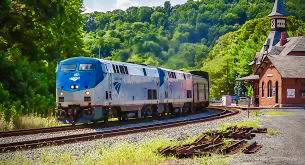 smaller, rural constituents and communities (Destination Dispersion, hello!). Amtrak proponents further claim that Team Anderson’s number crunchers massage the cost of running Northeast Corridor trains while overstating the losses on long-distant routes.
smaller, rural constituents and communities (Destination Dispersion, hello!). Amtrak proponents further claim that Team Anderson’s number crunchers massage the cost of running Northeast Corridor trains while overstating the losses on long-distant routes.
For his part, the CEO dismisses such cautionary blowback by projecting that Amtrak, through his fiscal measures and discipline, is on the brink of actually breaking even on  operating its trains—thanks primarily to existing corridors in the Northeast, midwest and as far west as Southern California, the Bay Area and on up to Seattle.
operating its trains—thanks primarily to existing corridors in the Northeast, midwest and as far west as Southern California, the Bay Area and on up to Seattle.
At the same time, Team Anderson is preparing to hit Congress for capital needs and ![]() infrastructure improvements in Amtrak’s reauthorization in the Hill’s 2020 session. This, as Amtrak is now reporting record ridership in 2019, some 32.5m ‘customer trips’, up over 800,000 from 2018—due largely to Northeast Corridor Acela service (up more than 4%), but with long-distance service also rising nearly 1%).
infrastructure improvements in Amtrak’s reauthorization in the Hill’s 2020 session. This, as Amtrak is now reporting record ridership in 2019, some 32.5m ‘customer trips’, up over 800,000 from 2018—due largely to Northeast Corridor Acela service (up more than 4%), but with long-distance service also rising nearly 1%).
These Amtrak increases translate to a healthy 3.6% jump in operating revenue over 2018. CEO Anderson tells Congress the railroad sees hitting a break-even point by summer 2020—through boosting revenue and capital investment while cutting costs—toward moving the national passenger railway into the black for the first time in its almost 50 year history. Still, such rosy projections remain to be fully and fairly ‘railized’ over the months ahead.
Use ’Em or Lose ’Em.
Between now and then, the fate of Amtrak’s national routes still hangs in the imbalance between the country’s esteemed heritage of long-distance rail travel and the reductive spreadsheet droids of today.
For us Vamigrés, it may be a matter of championing wider travel means and options, or witnessing the decimation of same over the long haul. No less than the end of storied railroad lines, of a coast-to-coast network that still works for many travelers, no matter what the numbers gainsay.
Fortunately, Congress doesn’t roll with truncated long-distant routes and bus bridges, insisting that those rural areas (and their constituents) must be served, that government has a role in supporting a historic national rail network for the public good.
Just know this dedicated Delta executive has his own sky-high agenda: A profitable, more privatized 21st century transportation system offering reasonable ticket prices. That he and his 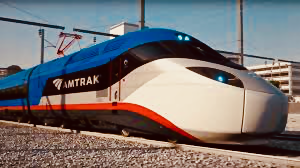 special interest/anti-rail cohorts will play hardball to highball it through.
special interest/anti-rail cohorts will play hardball to highball it through.
Reason enough for Vamigré to keep keen eyes trained on exactly which rails Amtrak will be riding in the months ahead (e.g.,bullet trains, etc.), and how the nation’s railway system will fare. (MTC…)
